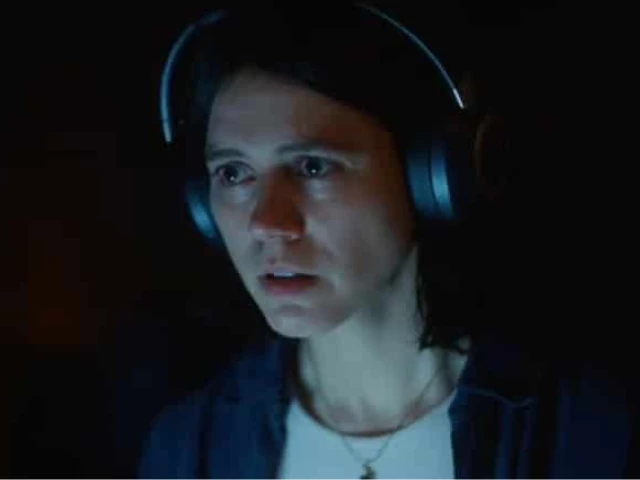Our powerful, modern, ground-based telescopes have to deal with a lot of noise in the starlight they observe. The noise comes from Earth’s atmosphere, which forces telescopes to use solutions like adaptive optics to filter it out. Researchers at the University of Warwick in the UK, in partnership with Spanish institutions, are developing a method to use that noise to measure greenhouse gases (GHGs) in Earth’s atmosphere.
Earth’s atmospheric carbon won’t just disappear if we stop measuring it. More and more carbon is accumulating in the atmosphere and the effects of that carbon are felt in our warming world. There are many different ways to measure that carbon and determine how it affects different parts of the world, and how it affects agriculture, drought, receding ice, and forest fires. Since we have so many telescopes operating around the world, maybe they can contribute to these measurements.
When observing distant objects, astronomers often use spectroscopy to determine the chemical contents of exoplanet atmospheres, stars, and other objects like gas clouds. All molecules have spectroscopic fingerprints that reveal their presence. Telluric contamination is the effect that Earth’s atmospheric molecules have on the starlight observed by telescopes. It introduces telluric lines into observations that make the signal from distant objects noisy. They can mask or mimic the spectroscopic lines from the target object.
A PhD student in the Astronomy and Astrophysics group at Warwick University, Marcelo Aron Fetzner Keniger, has developed a way to use these contaminating telluric lines to measure GHGs. It’s called Astroclimes, and it can measure molecules like methane, carbon dioxide, and water vapour in our planet’s atmosphere.
“Monitoring the abundance of GHGs is necessary to quantify their impact on global warming and climate change,” Keniger said in a press release. “Using telluric lines to measure the abundance of GHGs in the Earth’s atmosphere has been extensively employed using solar spectra, for example by the COllaborative Carbon Column Observing Network (COCCON). However, since they rely on solar spectra, these measurements can only be carried out during the day, so Astroclimes can hopefully fill the gap with nighttime measurements.”
This is a plot from the Astroclimes algorithm showing Telluric lines. Image Credit: Marcelo Aron Fetzner Keniger/University of Warwick
The University of Warwick collaborated with Calar Alto Astronomical Observatory (CAHA) in Almería, Spain, the University of Almería and the Spanish State Meteorological Agency (AEMET on an observing campaign in July to test Astroclimes. The goal was to show how combining night-time observations of stars with Astroclimes with day-time observations of the Sun can help scientists study Earth’s carbon cycle and the role that GHGs play.
“Astroclimes can measure the abundance of greenhouse gases on Earth by generating a model telluric transmission spectra and fitting it to the spectra of telluric standard stars in the near-infrared taken by ground-based telescopes,” Keniger said in a presentation to the Royal Meteorological Society.
CAHA hosts several telescopes, including a 3.5 meter telescope with the CARMENES (Calar Alto high-Resolution search for M-dwarfs with Exoearths with Near-infrared and optical Échelle Spectrographs). CARMENES was used with the Astroclimes algorithm during nighttime observations, while a temporary, portable FTIR spectrometer (EM27/SUN) from the COCCON-Spain network was used during the day. The COCCON instrument can measure GHG concentrations and calibrate the readings from CARMENES.
“If we can successfully calibrate Astroclimes with the help of COCCON measurements, it could provide a new network for measuring GHG abundances, complementing current networks with nighttime measurements,” Keniger said.
It’s not a simple task, though. Telluric lines not only change due to different GHGs; changing temperature, humidity, and pressure can also alter them.
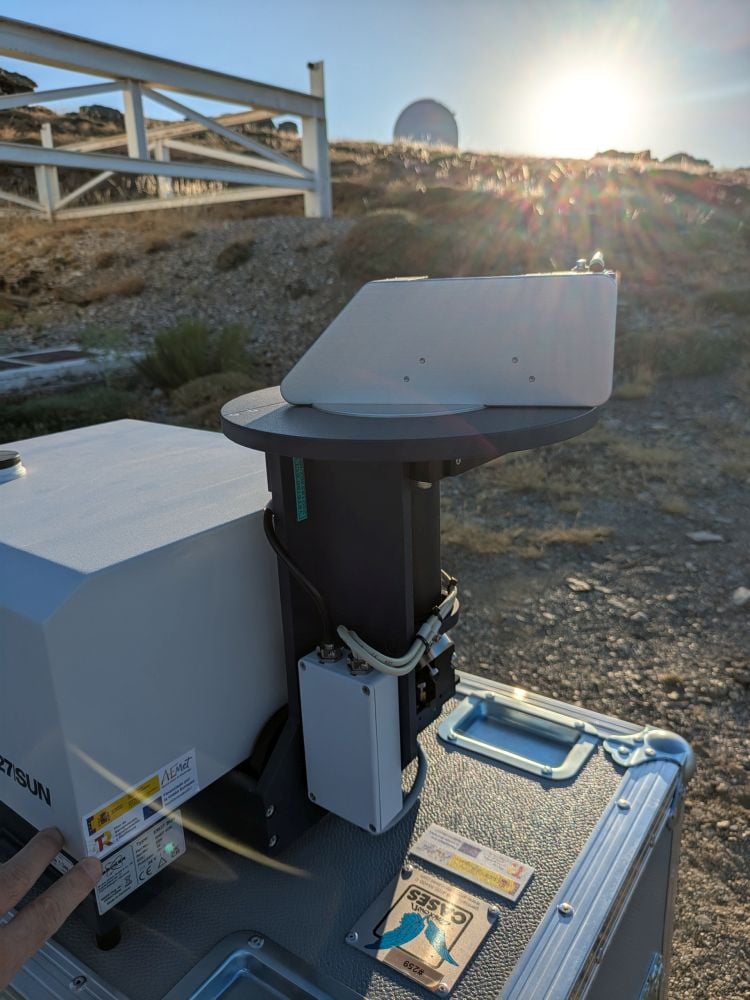 This image shows the EM27/SUN instrument of the COCCON-Spain network observing the Sun, almost in the direction of the CAHA 3.5 m telescope. Image Credit: Calar Alto Observatory (CAHA)
This image shows the EM27/SUN instrument of the COCCON-Spain network observing the Sun, almost in the direction of the CAHA 3.5 m telescope. Image Credit: Calar Alto Observatory (CAHA)
EM27/SUN is at about 2,100 meters in altitude, and its measurements were combined with an instrument at sea level at the University of Almería (UAL). Joaquín Alonso Montesinos is a Professor at UAL and is the representative of the UAL in the COCCON-Spain project. Montesinos said, “We are grateful to AEMET for counting on us for such an important project, which we believe will be a benchmark in the energy transition.”
The COCCON-Spain project is intended to be an integrated GHG observation system for the country. There is a gap in the observation of GHGs in Spain, and COCCON aims to fill that gap. Initially, it will consist of 12 stations that measure background GHG concentrations as well as concentrations near major urban/industrial greenhouse gas emission zones.
“The COCCON-Spain national network aims to address the latent lack of atmospheric GHG observations in Spain through the implementation of a network of stations for measurement on a national scale. One of the main objectives of the COCCON-Spain network is to improve current knowledge of GHG sources and sinks, thus contributing to the development of mitigation and adaptation strategies for climate change,” said Omaira García-Rodríguez (AEMET-CIAI), coordinator of the network.
COCCON and Astroclimes dovetail nicely with the Calar Alto observatory. Observatories are typically placed in environments that are isolated and not connected to power grids. In Calar Alto’s case, it burns diesel to generate electricity and heat water, generating more than 100 tons of CO2 annually. The observatory is turning itself into a low-carbon energy island with the addition of solar panels and a biomass boiler to replace diesel fuel.
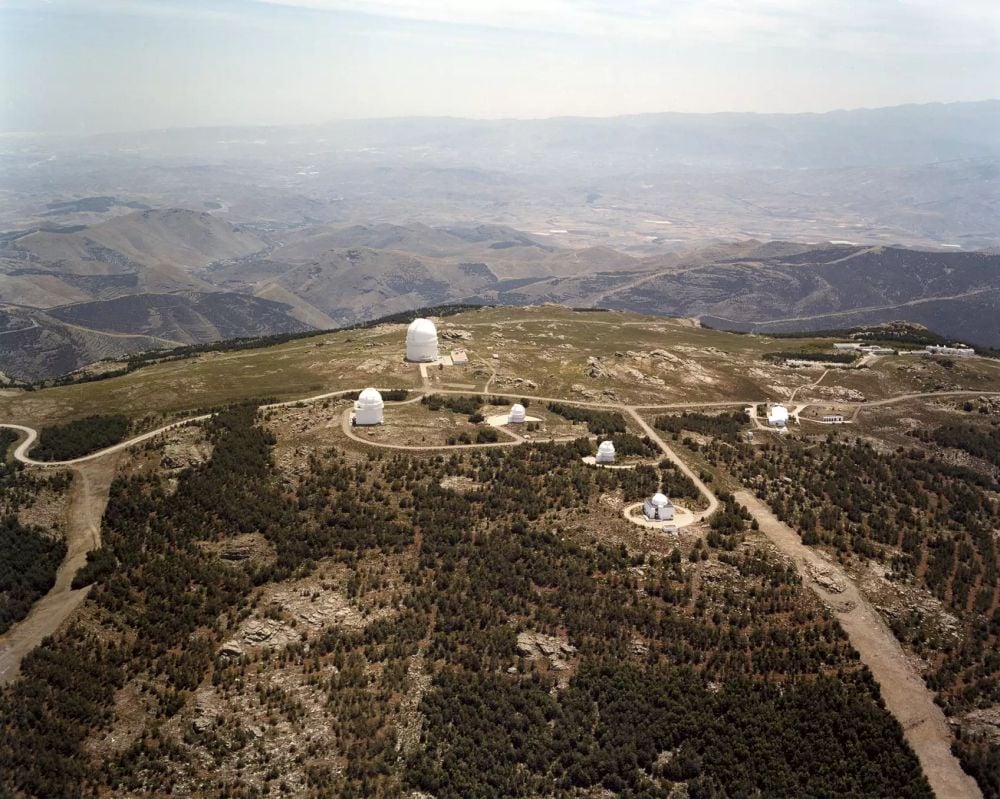 Aerial view of the Calar Alto Observatory from the north at the telescope domes. From left to right: the 2.2-m telescope, the Spanish 1.5-m telescope (in the foreground), the 1.2-m telescope, the Schmidt-reflector and the dome of the 3.5-m telescope with a height of 43 m. In the background the coast of Almería is seen. Credit: MPIA
Aerial view of the Calar Alto Observatory from the north at the telescope domes. From left to right: the 2.2-m telescope, the Spanish 1.5-m telescope (in the foreground), the 1.2-m telescope, the Schmidt-reflector and the dome of the 3.5-m telescope with a height of 43 m. In the background the coast of Almería is seen. Credit: MPIA
“Due to the peculiar characteristics of the environments surrounding professional astronomical observatories, the costs in fuel and electricity are high” said Jesús Aceituno, director of the observatory and principal investigator of the project. “By implementing the Calar Alto energy island, we pretend to be a world reference for other professional observatories as a management model that helps the environment, with an estimated reduction of a hundred and sixty tons of carbon dioxide per year and the resulting optimization of the associated costs”.
“Calar Alto, with its photovoltaic plant and biomass boiler, aims at reaching energy sustainability. These greenhouse gas detections made with CARMENES demonstrate that an astronomical observatory can also serve to monitor our planet’s climate,” said Aceituno.
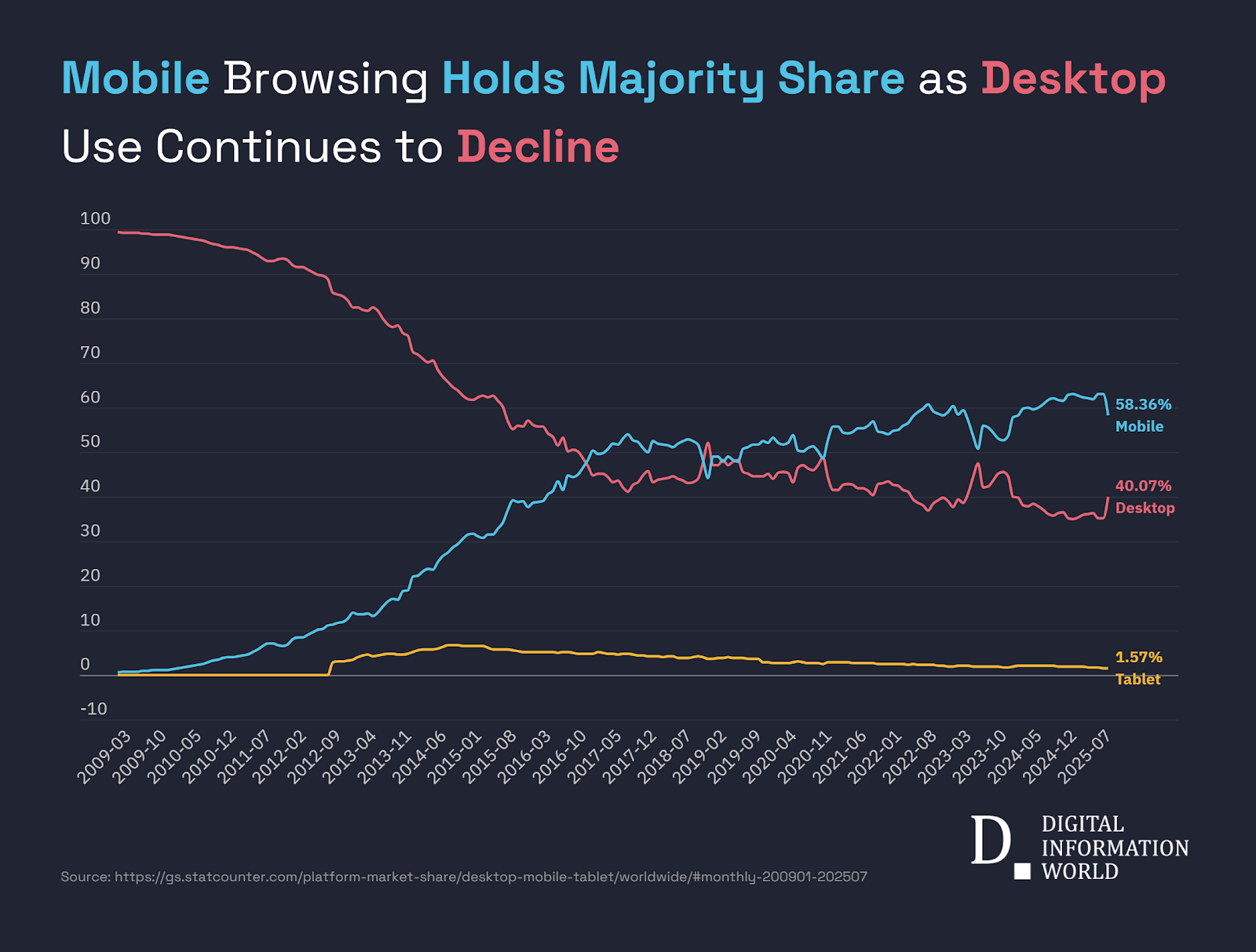

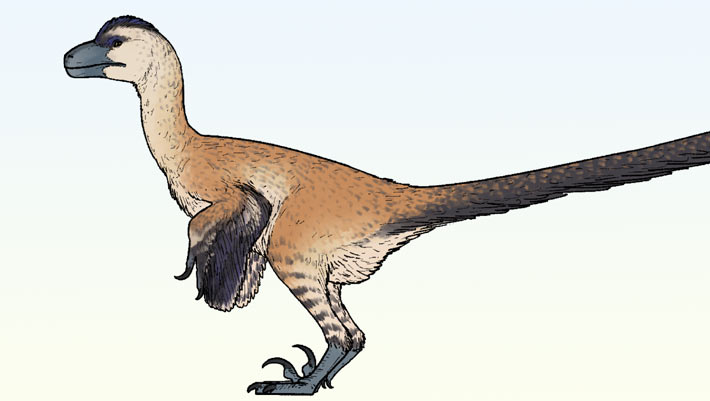
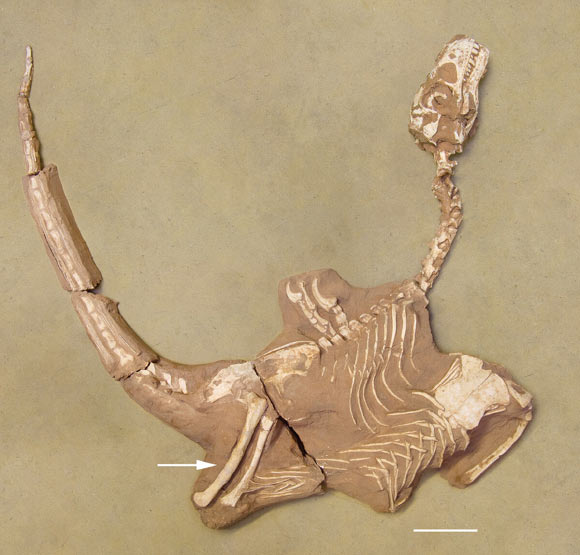


 This image shows the EM27/SUN instrument of the COCCON-Spain network observing the Sun, almost in the direction of the CAHA 3.5 m telescope. Image Credit: Calar Alto Observatory (CAHA)
This image shows the EM27/SUN instrument of the COCCON-Spain network observing the Sun, almost in the direction of the CAHA 3.5 m telescope. Image Credit: Calar Alto Observatory (CAHA) Aerial view of the Calar Alto Observatory from the north at the telescope domes. From left to right: the 2.2-m telescope, the Spanish 1.5-m telescope (in the foreground), the 1.2-m telescope, the Schmidt-reflector and the dome of the 3.5-m telescope with a height of 43 m. In the background the coast of Almería is seen. Credit: MPIA
Aerial view of the Calar Alto Observatory from the north at the telescope domes. From left to right: the 2.2-m telescope, the Spanish 1.5-m telescope (in the foreground), the 1.2-m telescope, the Schmidt-reflector and the dome of the 3.5-m telescope with a height of 43 m. In the background the coast of Almería is seen. Credit: MPIA